height Hyundai Elantra 2015 Owner's Manual - RHD (UK. Australia)
[x] Cancel search | Manufacturer: HYUNDAI, Model Year: 2015, Model line: Elantra, Model: Hyundai Elantra 2015Pages: 498, PDF Size: 9.45 MB
Page 20 of 498
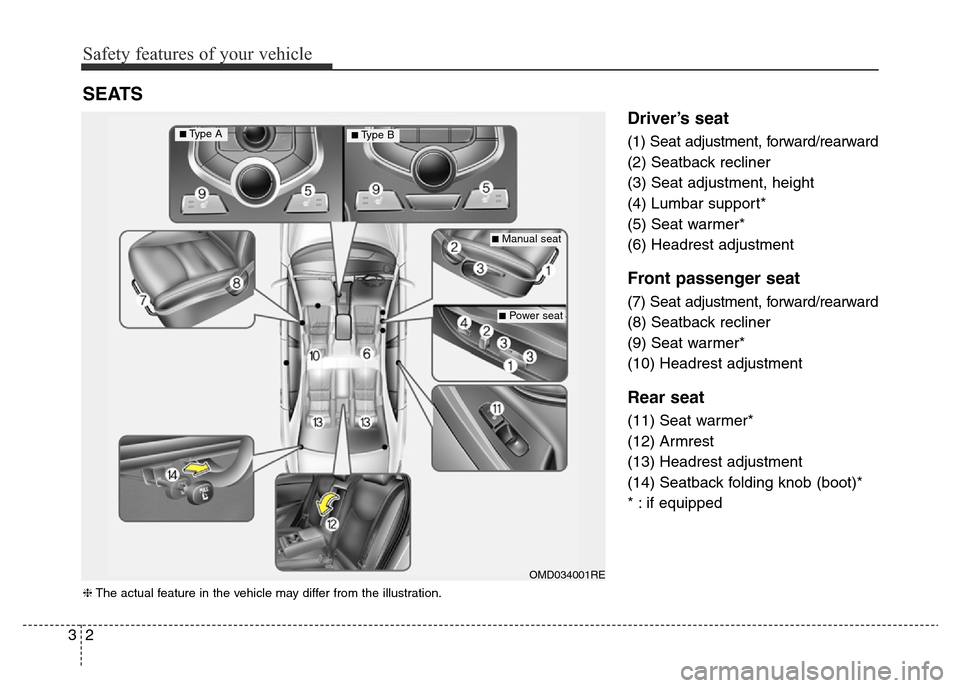
Safety features of your vehicle
2 3
Driver’s seat
(1) Seat adjustment, forward/rearward
(2) Seatback recliner
(3) Seat adjustment, height
(4) Lumbar support*
(5) Seat warmer*
(6) Headrest adjustment
Front passenger seat
(7) Seat adjustment, forward/rearward
(8) Seatback recliner
(9) Seat warmer*
(10) Headrest adjustment
Rear seat
(11) Seat warmer*
(12) Armrest
(13) Headrest adjustment
(14) Seatback folding knob (boot)*
* : if equipped
SEATS
❈The actual feature in the vehicle may differ from the illustration.
OMD034001RE
■Manual seat
■Power seat
■Type A■Type B
Page 24 of 498
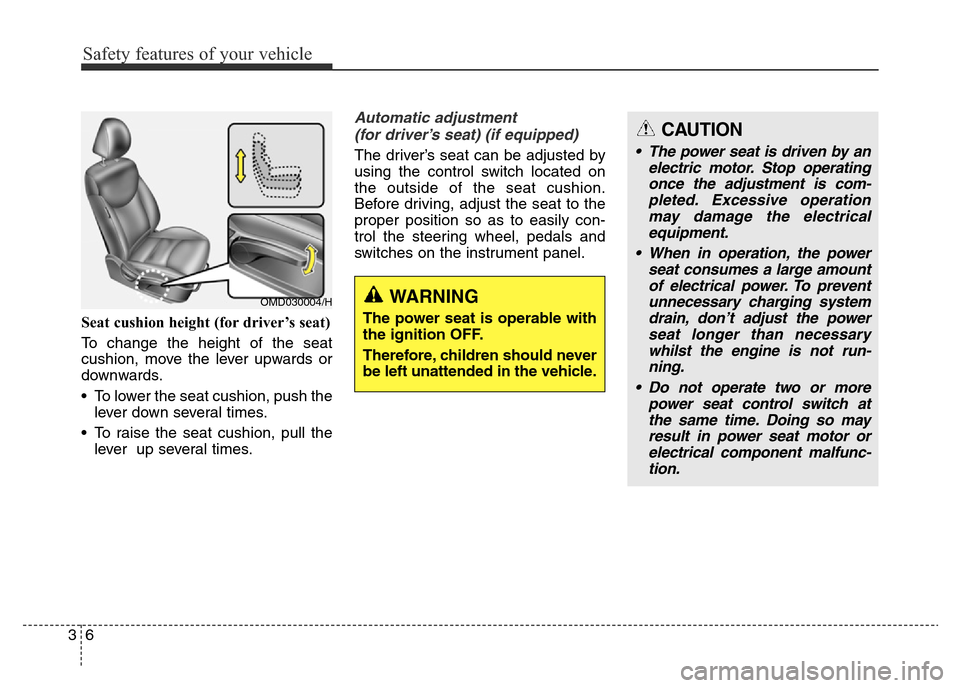
Safety features of your vehicle
6 3
Seat cushion height (for driver’s seat)
To change the height of the seat
cushion, move the lever upwards or
downwards.
• To lower the seat cushion, push the
lever down several times.
• To raise the seat cushion, pull the
lever up several times.
Automatic adjustment
(for driver’s seat) (if equipped)
The driver’s seat can be adjusted by
using the control switch located on
the outside of the seat cushion.
Before driving, adjust the seat to the
proper position so as to easily con-
trol the steering wheel, pedals and
switches on the instrument panel.
OMD030004/HWARNING
The power seat is operable with
the ignition OFF.
Therefore, children should never
be left unattended in the vehicle.
CAUTION
• The power seat is driven by an
electric motor. Stop operating
once the adjustment is com-
pleted. Excessive operation
may damage the electrical
equipment.
• When in operation, the power
seat consumes a large amount
of electrical power. To prevent
unnecessary charging system
drain, don’t adjust the power
seat longer than necessary
whilst the engine is not run-
ning.
• Do not operate two or more
power seat control switch at
the same time. Doing so may
result in power seat motor or
electrical component malfunc-
tion.
Page 25 of 498
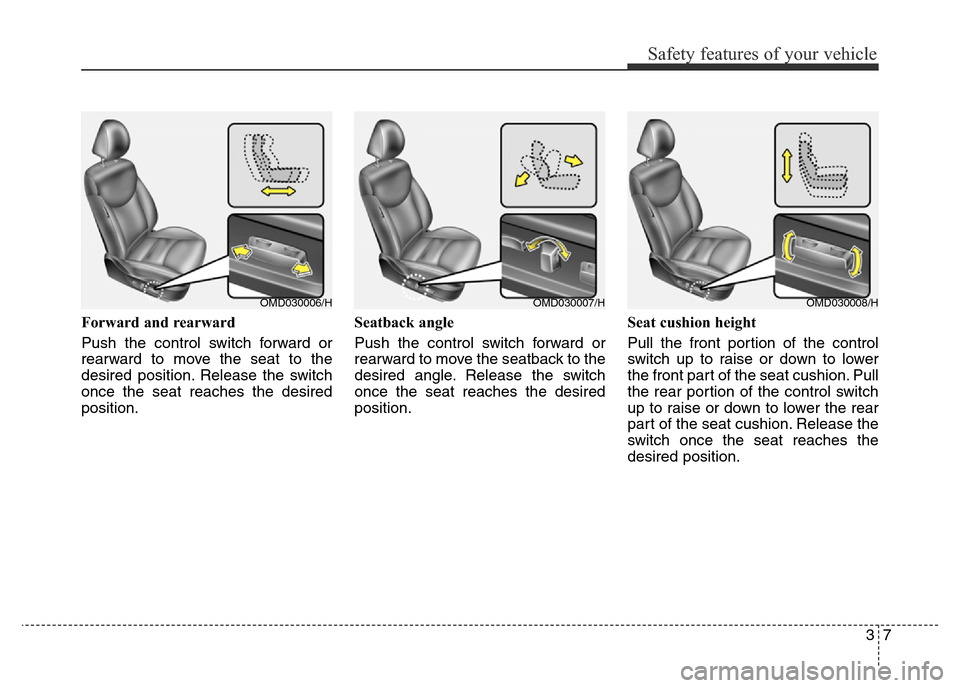
37
Safety features of your vehicle
Forward and rearward
Push the control switch forward or
rearward to move the seat to the
desired position. Release the switch
once the seat reaches the desired
position.Seatback angle
Push the control switch forward or
rearward to move the seatback to the
desired angle. Release the switch
once the seat reaches the desired
position.Seat cushion height
Pull the front portion of the control
switch up to raise or down to lower
the front part of the seat cushion. Pull
the rear portion of the control switch
up to raise or down to lower the rear
part of the seat cushion. Release the
switch once the seat reaches the
desired position.
OMD030006/HOMD030007/HOMD030008/H
Page 26 of 498
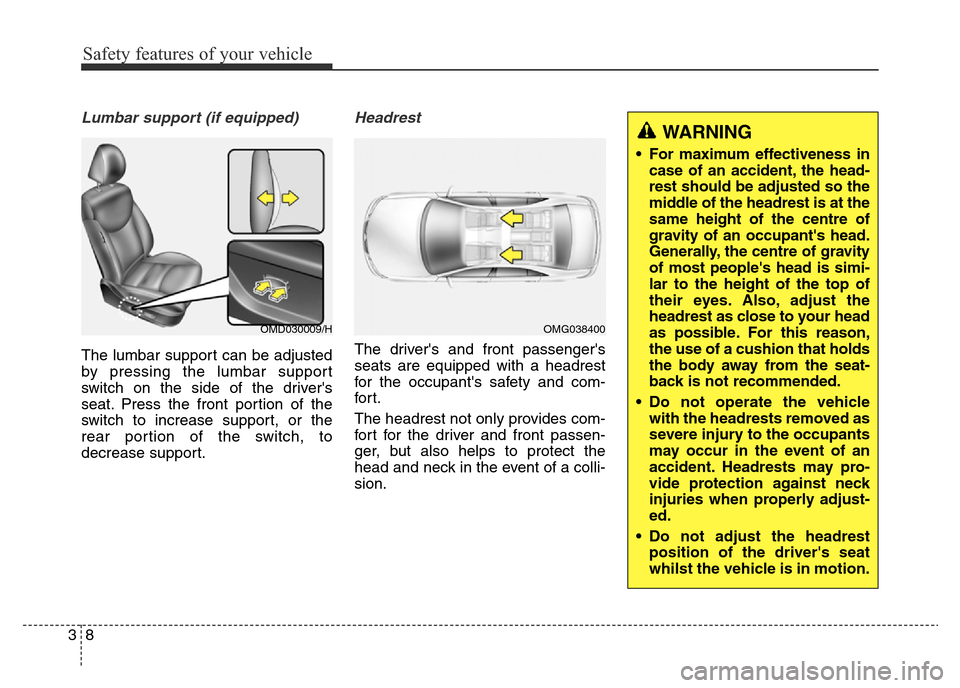
Safety features of your vehicle
8 3
Lumbar support (if equipped)
The lumbar support can be adjusted
by pressing the lumbar support
switch on the side of the driver's
seat. Press the front portion of the
switch to increase support, or the
rear portion of the switch, to
decrease support.
Headrest
The driver's and front passenger's
seats are equipped with a headrest
for the occupant's safety and com-
for t.
The headrest not only provides com-
fort for the driver and front passen-
ger, but also helps to protect the
head and neck in the event of a colli-
sion.
OMD030009/HOMG038400
WARNING
• For maximum effectiveness in
case of an accident, the head-
rest should be adjusted so the
middle of the headrest is at the
same height of the centre of
gravity of an occupant's head.
Generally, the centre of gravity
of most people's head is simi-
lar to the height of the top of
their eyes. Also, adjust the
headrest as close to your head
as possible. For this reason,
the use of a cushion that holds
the body away from the seat-
back is not recommended.
• Do not operate the vehicle
with the headrests removed as
severe injury to the occupants
may occur in the event of an
accident. Headrests may pro-
vide protection against neck
injuries when properly adjust-
ed.
• Do not adjust the headrest
position of the driver's seat
whilst the vehicle is in motion.
Page 27 of 498
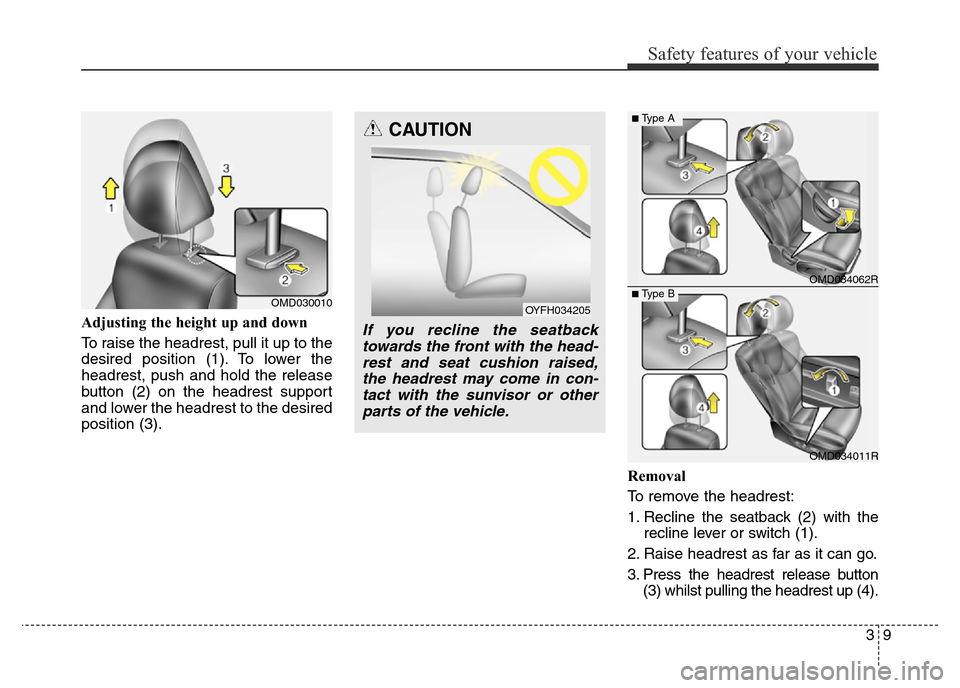
39
Safety features of your vehicle
Adjusting the height up and down
To raise the headrest, pull it up to the
desired position (1). To lower the
headrest, push and hold the release
button (2) on the headrest support
and lower the headrest to the desired
position (3).
Removal
To remove the headrest:
1. Recline the seatback (2) with the
recline lever or switch (1).
2. Raise headrest as far as it can go.
3. Press the headrest release button
(3) whilst pulling the headrest up (4).
OMD030010
OMD034062R
OMD034011R
■Type A
■ Type B
CAUTION
If you recline the seatback
towards the front with the head-
rest and seat cushion raised,
the headrest may come in con-
tact with the sunvisor or other
parts of the vehicle.
OYFH034205
Page 28 of 498
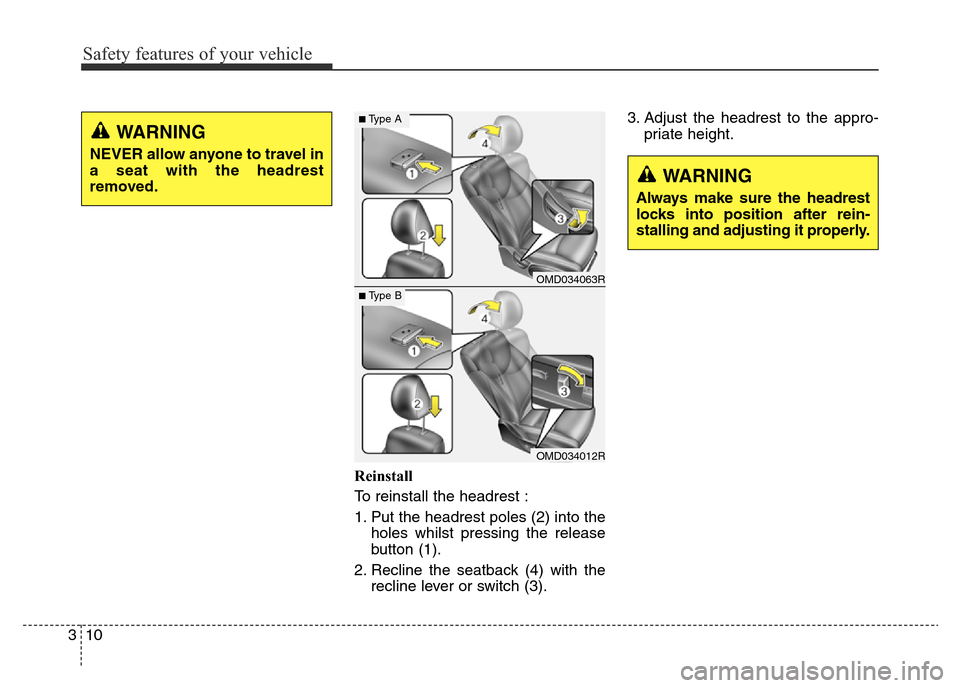
Safety features of your vehicle
10 3
Reinstall
To reinstall the headrest :
1. Put the headrest poles (2) into the
holes whilst pressing the release
button (1).
2. Recline the seatback (4) with the
recline lever or switch (3).3. Adjust the headrest to the appro-
priate height.
OMD034063R
OMD034012R
■Type A
■ Type B
WARNING
NEVER allow anyone to travel in
a seat with the headrest
removed.
WARNING
Always make sure the headrest
locks into position after rein-
stalling and adjusting it properly.
Page 31 of 498
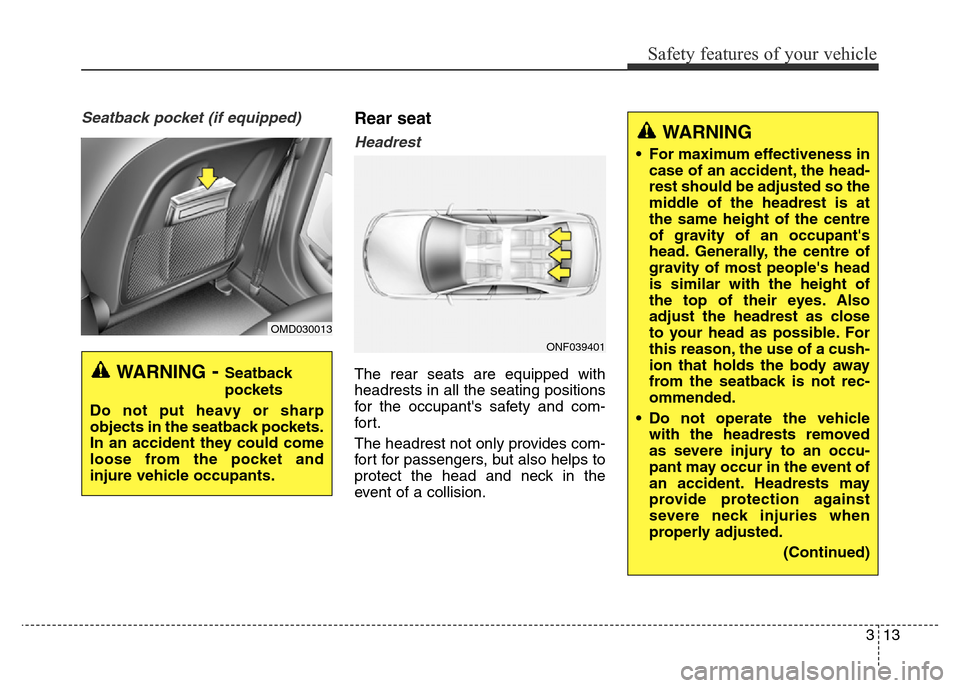
313
Safety features of your vehicle
Seatback pocket (if equipped)Rear seat
Headrest
The rear seats are equipped with
headrests in all the seating positions
for the occupant's safety and com-
for t.
The headrest not only provides com-
fort for passengers, but also helps to
protect the head and neck in the
event of a collision.WARNING- Seatback
pockets
Do not put heavy or sharp
objects in the seatback pockets.
In an accident they could come
loose from the pocket and
injure vehicle occupants.
OMD030013
ONF039401
WARNING
• For maximum effectiveness in
case of an accident, the head-
rest should be adjusted so the
middle of the headrest is at
the same height of the centre
of gravity of an occupant's
head. Generally, the centre of
gravity of most people's head
is similar with the height of
the top of their eyes. Also
adjust the headrest as close
to your head as possible. For
this reason, the use of a cush-
ion that holds the body away
from the seatback is not rec-
ommended.
• Do not operate the vehicle
with the headrests removed
as severe injury to an occu-
pant may occur in the event of
an accident. Headrests may
provide protection against
severe neck injuries when
properly adjusted.
(Continued)
Page 32 of 498
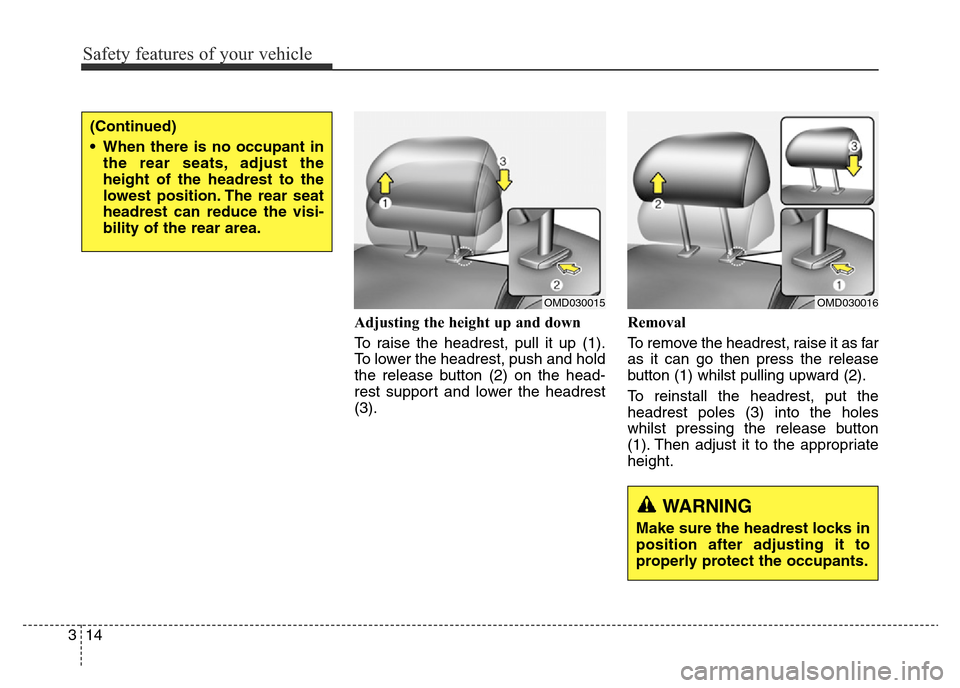
Safety features of your vehicle
14 3
Adjusting the height up and down
To raise the headrest, pull it up (1).
To lower the headrest, push and hold
the release button (2) on the head-
rest support and lower the headrest
(3).Removal
To remove the headrest, raise it as far
as it can go then press the release
button (1) whilst pulling upward (2).
To reinstall the headrest, put the
headrest poles (3) into the holes
whilst pressing the release button
(1). Then adjust it to the appropriate
height.
(Continued)
• When there is no occupant in
the rear seats, adjust the
height of the headrest to the
lowest position. The rear seat
headrest can reduce the visi-
bility of the rear area.
OMD030016
WARNING
Make sure the headrest locks in
position after adjusting it to
properly protect the occupants.
OMD030015
Page 42 of 498
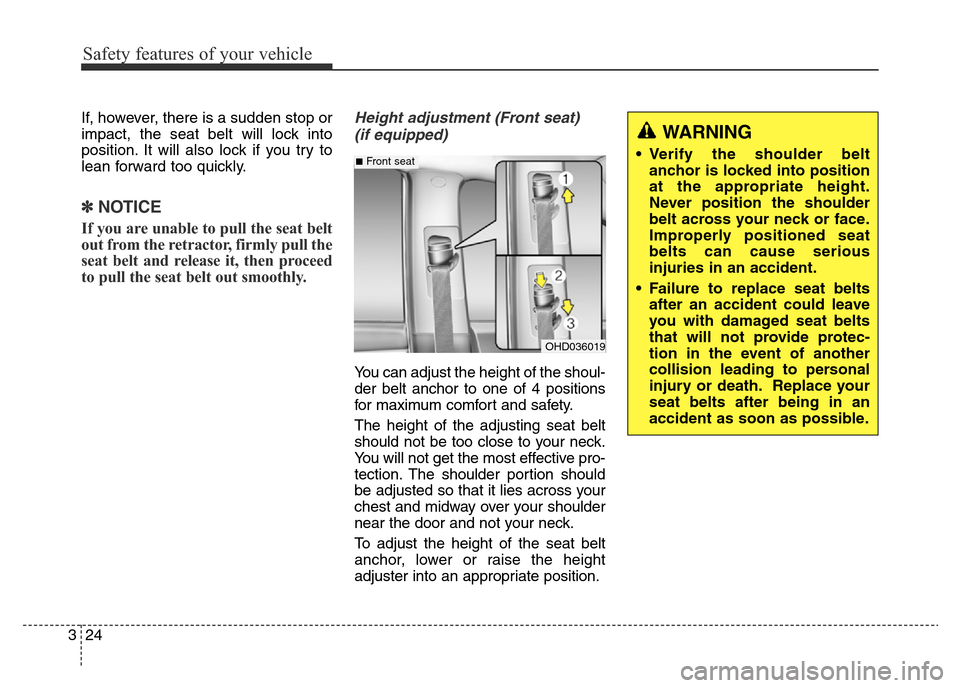
Safety features of your vehicle
24 3
If, however, there is a sudden stop or
impact, the seat belt will lock into
position. It will also lock if you try to
lean forward too quickly.
✽NOTICE
If you are unable to pull the seat belt
out from the retractor, firmly pull the
seat belt and release it, then proceed
to pull the seat belt out smoothly.
Height adjustment (Front seat)
(if equipped)
You can adjust the height of the shoul-
der belt anchor to one of 4 positions
for maximum comfort and safety.
The height of the adjusting seat belt
should not be too close to your neck.
You will not get the most effective pro-
tection. The shoulder portion should
be adjusted so that it lies across your
chest and midway over your shoulder
near the door and not your neck.
To adjust the height of the seat belt
anchor, lower or raise the height
adjuster into an appropriate position.
OHD036019
■Front seat
WARNING
• Verify the shoulder belt
anchor is locked into position
at the appropriate height.
Never position the shoulder
belt across your neck or face.
Improperly positioned seat
belts can cause serious
injuries in an accident.
• Failure to replace seat belts
after an accident could leave
you with damaged seat belts
that will not provide protec-
tion in the event of another
collision leading to personal
injury or death. Replace your
seat belts after being in an
accident as soon as possible.
Page 47 of 498
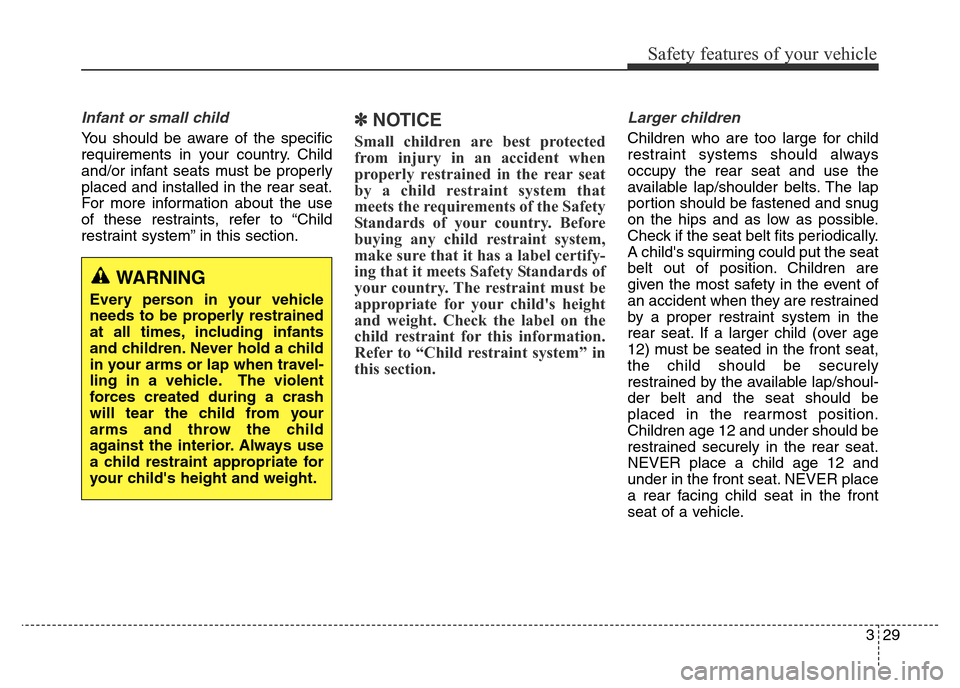
329
Safety features of your vehicle
Infant or small child
You should be aware of the specific
requirements in your country. Child
and/or infant seats must be properly
placed and installed in the rear seat.
For more information about the use
of these restraints, refer to “Child
restraint system” in this section.
✽NOTICE
Small children are best protected
from injury in an accident when
properly restrained in the rear seat
by a child restraint system that
meets the requirements of the Safety
Standards of your country. Before
buying any child restraint system,
make sure that it has a label certify-
ing that it meets Safety Standards of
your country. The restraint must be
appropriate for your child's height
and weight. Check the label on the
child restraint for this information.
Refer to “Child restraint system” in
this section.
Larger children
Children who are too large for child
restraint systems should always
occupy the rear seat and use the
available lap/shoulder belts. The lap
portion should be fastened and snug
on the hips and as low as possible.
Check if the seat belt fits periodically.
A child's squirming could put the seat
belt out of position. Children are
given the most safety in the event of
an accident when they are restrained
by a proper restraint system in the
rear seat. If a larger child (over age
12) must be seated in the front seat,
the child should be securely
restrained by the available lap/shoul-
der belt and the seat should be
placed in the rearmost position.
Children age 12 and under should be
restrained securely in the rear seat.
NEVER place a child age 12 and
under in the front seat. NEVER place
a rear facing child seat in the front
seat of a vehicle.
WARNING
Every person in your vehicle
needs to be properly restrained
at all times, including infants
and children. Never hold a child
in your arms or lap when travel-
ling in a vehicle. The violent
forces created during a crash
will tear the child from your
arms and throw the child
against the interior. Always use
a child restraint appropriate for
your child's height and weight.